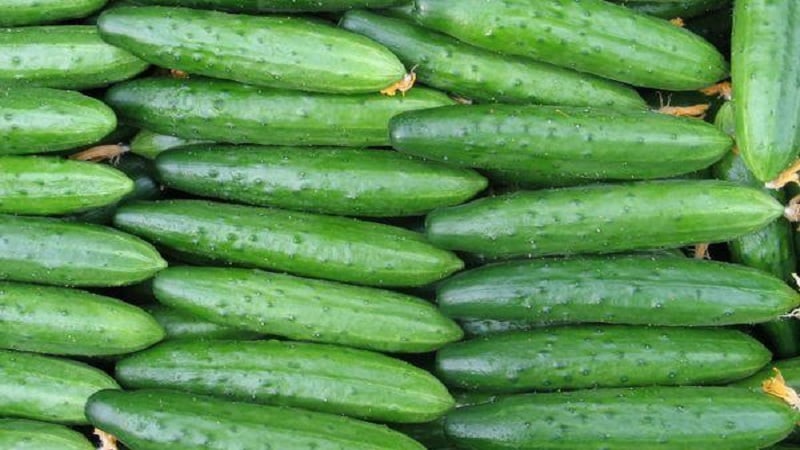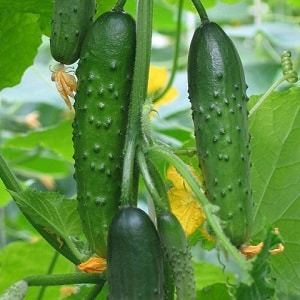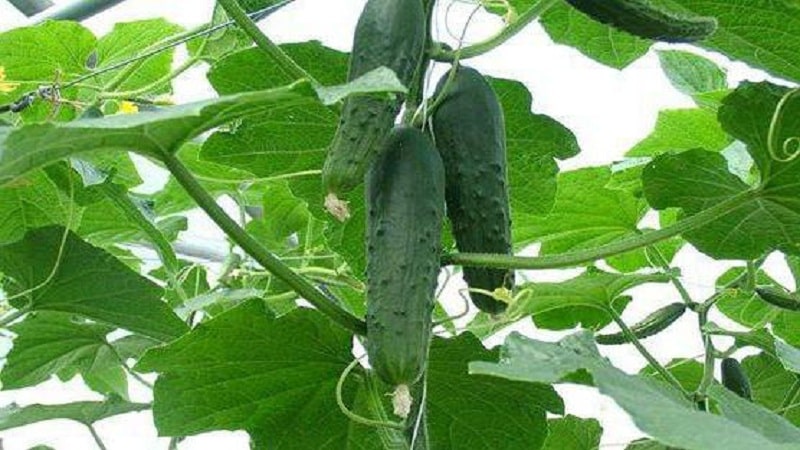Review of the hybrid cucumber "Emelya": advantages and disadvantages, care features
Hybrids are popular in the seed market due to their ease of care, resistance to bad weather, infectious diseases and long-term fruiting. One of them is the Emelya parthenocarpic f1. The crop is suitable for cultivation in all regions of the country, adapts to any growing conditions, is characterized by early ripening and high productivity.
We have prepared for you information about the nuances of agricultural technology for these cucumbers, their advantages and disadvantages.
Description of the variety
Emelya f1 is a product of selection work of biologists of the domestic seed-growing company "Manul". Included in the State Register of Russia in 2002 as a hybrid intended for cultivation in greenhouses and greenhouses.
The bushes are indeterminate, vigorous, medium-branched, with a female type of flowering. The formation of ovaries is fascicular.
The culture is cold-resistant, with friendly fruiting. 7–10 fruits are formed in one leaf node.
In the photo - Emelya cucumbers.

The distinctive features of the hybrid are shown in the table.
| Indicators | Characteristic |
| Ripening period | 39-43 days |
| Pollination type | Parthenocarpic |
| Weight | 120–150 g |
| Length | 13–15 cm |
| Form | Fusiform |
| Coloring | Green, with light stripes |
| Leaves | Medium size, green in color, slightly wrinkled, with slightly wavy edges |
| Pulp | Dense, crispy, without voids |
| Taste | Sweetish, without bitterness |
| Skin | Thin, with small sparse tubercles and white pubescence |
| Purpose | Universal |
| Productivity | 12–16 kg/m² |
| Sustainability | To cucumber mosaic virus, olive spot |
| Transportability | High |
Composition, calorie content and benefits
Nutritional value of cucumbers (per 100 g):
- calorie content - 14 kcal;
- proteins - 0.8 g;
- fats - 0.1 g;
- carbohydrates - 2.5 g;
- water - 95 g;
- fiber - 1 g.
Cucumbers are also rich in vitamins and minerals - see the table for more details.
| Name | Content | Norm |
| Vitamin A | 10 mcg | 900 mcg |
| Beta carotene | 0.06 mg | 5 mg |
| Vitamin B1 | 0.03 mg | 1.5 mg |
| Vitamin B2 | 0.04 mg | 1.8 mg |
| Vitamin B4 | 6 mg | 500 mg |
| Vitamin B5 | 0.27 mg | 5 mg |
| Vitamin B6 | 0.04 mg | 2 mg |
| Vitamin B9 | 4 mcg | 400 mcg |
| Vitamin C | 10 mg | 90 mg |
| Vitamin E | 0.1 mg | 15 mg |
| Vitamin H | 0.9 mcg | 50 mcg |
| Vitamin K | 16.4 mcg | 120 mcg |
| Vitamin PP | 0.3 mg | 20 mg |
| Potassium | 141 mg | 2500 mg |
| Calcium | 23 mg | 1000 mg |
| Silicon | 53 mg | 30 mg |
| Magnesium | 14 mg | 400 mg |
| Sodium | 8 mg | 1300 mg |
| Sulfur | 6.5 mg | 1000 mg |
| Phosphorus | 42 mg | 800 mg |
| Chlorine | 25 mg | 2300 mg |
| Iron | 0.6 mg | 18 mg |
| Iodine | 3 mcg | 150 mcg |
| Manganese | 0.18 mg | 2 mg |
| Copper | 100 mcg | 1000 mcg |
| Selenium | 0.3 mcg | 55 mcg |
| Fluorine | 17 mcg | 4000 mcg |
| Chromium | 6 mcg | 50 mcg |
| Zinc | 0.215 mg | 12 mg |
Benefits for the body:
- lignans and cucurbitacins destroy cancer cells and reduce the risk of cancer;
- vitamin K maintains the strength of the skeletal system;
- potassium strengthens the cardiovascular system;
- fiber normalizes the functioning of the gastrointestinal tract;
- Vitamin C whitens freckles and age spots.
Hybrid agricultural technology
Emelya cucumbers are grown by direct sowing of seeds in the ground and through seedlings. Maintenance involves frequent loosening, weeding, watering, applying mineral and organic fertilizers, maintaining optimal temperature and humidity in the greenhouse, shaping the bushes and tying them to the trellis.
Planting by seed
Direct sowing into the soil is carried out when it warms up to +18°C, and the air warms up to +23°C. The culture grows well in light, loose and nutritious soil with neutral acidity (pH = 6.5-7). To check, litmus strips are used, which are sold in gardening stores. Lime, dolomite flour, wood ash, and chalk help normalize acidity.
Seeds without a colored shell are pickled in a 1% solution of potassium permanganate (1 g/100 ml of water) and soaked in growth stimulants “Epin” or “Zircon”.
The timing of sowing is determined depending on the climatic zone: in the southern regions - in the first ten days of May, in the middle regions - in the third ten days of May or in the first ten days of June.
The soil is first loosened and fertilized with mullein solution (10 l/1 m²).
Using a bayonet shovel, beds are formed 70 cm wide and 20 cm deep. Then the area is leveled with an iron rake. A 1-2 cm depression is formed in the middle and filled with a hot dark solution of potassium permanganate.
After planting the seeds, the furrows are sprinkled with moist soil or peat. Black agrofibre is stretched over the top to protect against low temperatures, maintain humidity and ensure friendly shoots.
The cover is removed after the sprouts appear. The beds are thinned out, pinching out weak seedlings.
Planting by seedlings
Work on growing cucumber seedlings begins 20-30 days before transferring to a permanent place. Sowing technology is standard for all cucumbers.
The treated seeds are embedded in a substrate prepared from humus, peat and river sand in a ratio of 2:2:1. The soil is disinfected with a strong solution of potassium permanganate, “Fitosporin”, heated in an oven at a temperature of +110°C or in a double boiler for 20–30 minutes.
Advice. Before sowing seedlings, germinate the seeds on damp cotton cloth for 2-3 days.
To grow cucumber seedlings, use 0.5 liter peat pots. This reduces the risk of damage to the weak root system, because the sprouts can be planted in the holes without removing them from the containers.
The container is filled with a damp substrate and one sprouted grain is embedded to a depth of 1-1.5 cm. A plastic film is stretched over the top and left in a warm room.
It is removed after germination and placed on the brightest windowsill in the house. For irrigation, use warm spring or settled water. Watering frequency - once every 7 days. The seedlings are inspected to identify weak specimens and cut off with scissors.
They dive it into a permanent place at the stage of 3-5 true leaves. Planting pattern: 20x70 cm, 3 bushes per 1 m². They try not to deepen the roots so as not to provoke infection of the bushes with root rot.
Care
The agricultural technology of the Emelya f1 hybrid is not fundamentally different from the care of other parthenocarpics. The density of planting seedlings in a greenhouse is 2.5 bushes per 1 m², in the garden - 3-4 bushes per 1 m².
Installing a drip irrigation system makes it easier to care for the crop. Through it, a regular supply of water and liquid mineral fertilizers is provided.
The bushes are watered manually from a watering can at the roots, trying not to get on the leaves. Watering is carried out in the morning or evening to prevent sunburn.
Important! Do not forget about loosening the soil after each watering and weeding. Mulch will help reduce the amount and frequency of weeding: the beds are covered with hay, straw, sawdust or pine needles.
The crop is grown on a trellis to create additional ventilation and rationally use space in the greenhouse and in the garden.
Cucumbers are fertilized at least 4-5 times per season with minerals and organic matter. The table shows an approximate feeding scheme depending on the stage of development.
| Stage of development | Fertilizer |
| Before flowering | 400 ml of liquid chicken manure per 10 liters of water. Use once after planting for root watering |
| During the flowering period | 1 tsp. urea, superphosphate, potassium sulfate per 10 liters of water. Water the bushes 10 days after the first feeding |
| During the fruiting period | 25 g of nitrophoska, 20 g of chicken manure/10 l of water. Water the cucumbers 10 days after the second feeding |
| To prolong fruiting | 10 g potassium sulfate, 500 ml cow dung/10 l. Water the bushes at the root |
| 10 g urea, 6 g potassium sulfate/10 l water. Spray plants in cloudy weather |
Features of cultivation and possible difficulties
Emelya cucumbers are resistant to cold weather - the bushes bear fruit even at low air temperatures.
The main stem of the hybrid has an unlimited growth point, but fruits are formed not only on it, but also on the shoots. Each of them grows 7-10 cucumbers.
Since parthenocarpics tend to quickly gain green mass, without proper shaping of the plant it will not be possible to achieve abundant fruiting. All the growth energy will go into the formation of foliage and shoots, not fruits.
Forming rules:
- remove all shoots and flowers in the axils of the first five leaves;
- leave six stepsons 20-25 cm long;
- pinch a few stepsons above and leave a length of 35-40 cm;
- tie the main stem to the trellis, pinching the crown, or wrap it around the crossbar several times, stopping the growth point.
An important rule for caring for cucumbers is to maintain indoor humidity at 75–80% and air temperature from +22 to +28°C.
At low humidity, fruit development slows down, leaves begin to dry out and age quickly, and the fruiting period decreases. With high humidity, fungal infections develop, roots and fruits rot.
To increase it, containers with water are installed in the greenhouse, while the doors and vents are kept open. Ventilating the room will help reduce humidity levels.
If the air temperature drops to a critical level of +8°C, the plantings are covered with white agrofibre.
Diseases and pests
The hybrid is resistant to olive spot, cucumber mosaic virus, root rot and powdery mildew. Plantings are often attacked by aphids, spider mites and whiteflies. The table contains signs of diseases and insect damage, and methods of combating them.
| Disease/pest | Signs | Treatment |
| Powdery mildew | White-yellow coating on stems and leaves, small brown balls, dew drops on greenery, dry leaves curled up | 1 liter of yogurt, whey or kefir per 10 liters of water. The number of treatments is not limited.
1/3 teaspoon of soda ash, 25 ml of liquid soap per 1 liter of water. Treat plantings once every seven days |
| Root rot (pythium rhizoctonia blight, fusarium blight) | Watery, slippery, dark spots on the leaves, wrinkled leaves of a dark brown color, destroyed tissue of the root collar and main root | Treatment with drugs: “Gamair”, “Planriz”, “Baktofit”, “Trichodermin”, “Pseudobacterin-2” |
| Spider mite | Small white dots on the back of leaves, thin cobwebs on bushes | 50 g of greens and dandelion flowers / 2 liters of water, leave for 3-4 hours and spray the bushes |
| Aphid | Drooping leaves, drops of honeydew, a large concentration of ants | Pour 500 g of dry grass into 10 liters of water. Leave in a warm place for 48 hours. Treat plants with a sprayer |
| Whitefly | Sticky coating on stems and leaves, many white larvae at an early stage and flocks of white moths at a late stage | Chop 300 g of garlic and add 1 liter of warm water. Close the container with a lid and leave for five days |
Disease prevention measures:
- disinfection of the area with a concentrated solution of potassium permanganate, copper sulfate;
- humidity level control;
- compliance with watering rules;
- destruction of infected bushes;
- crop rotation;
- sowing green manure.
Harvesting and application

Fruit harvesting begins 1.5 months after full germination. The culture is characterized by long-term fruiting and uniform yield.
Cucumbers do not overgrow, do not barrel, and are suitable for fresh consumption and preservation. The dense and crispy flesh does not soften during heat treatment, and no voids form inside.
The fruits tolerate transportation well and remain fresh for about three weeks in a cool place.
Advantages and disadvantages
Advantages of a hybrid:
- high productivity;
- thin skin and non-prickly sparse tubercles on the surface of the fruit;
- excellent sweetish taste without bitterness;
- disease resistance.
Flaws:
- predisposition to powdery mildew and root rot;
- the need to shape bushes.
Reviews
Many gardeners prefer the Emelya hybrid due to its cold resistance, strong immunity and fertility.
Anna, Ryazhsk: “Emelya settled in my greenhouse three years ago. The culture is unpretentious in care, the fruits ripen almost simultaneously and in large quantities, do not outgrow, and are stored for a long time.The taste is excellent. Cucumbers are good both in fresh salads and in a jar of pickle.”
Olga, Kemerovo: “I chose cucumbers for the greenhouse, focusing on the climate of our region. I chose Emelya and was right. The crop withstands cold, but I still cover the plantings with agrofibre when the temperature drops sharply. The pulp is dense, juicy, and not bitter. I feed the bushes with mullein, potassium and phosphorus.”
Conclusion
The parthenocarpic hybrid Emelya is suitable for growing indoors. The crop does not require additional pollination by bees, adapts to any climate, and forms ovaries at low air temperatures. The plant has strong immunity to olive spot and cucumber mosaic virus.
If you follow the rules of agricultural technology, you will certainly be able to get a tasty and rich harvest. We wish you a rich and tasty harvest!